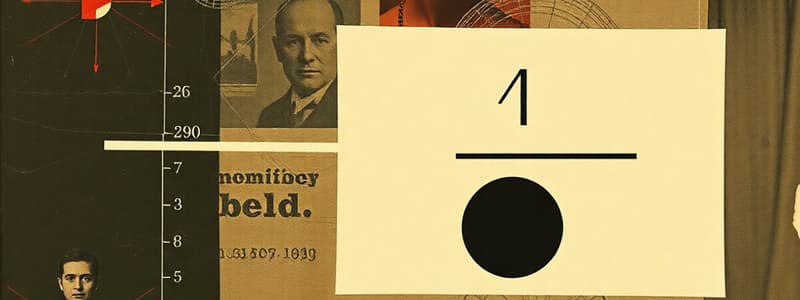Podcast
Questions and Answers
What is the primary requirement that must be met before adding or subtracting fractions?
What is the primary requirement that must be met before adding or subtracting fractions?
- Both fractions must have a common denominator. (correct)
- Both fractions must be expressed as mixed numbers.
- Both fractions must be proper fractions.
- Both fractions must be simplified.
Which of the following statements accurately describes the process of multiplying fractions?
Which of the following statements accurately describes the process of multiplying fractions?
- Convert the fractions to decimals and then multiply.
- Find a common denominator before multiplying the numerators and denominators.
- Multiply the numerators and denominators straight across, then simplify the result. (correct)
- Flip the second fraction and then multiply the numerators and denominators.
When dividing fractions, what is the purpose of 'keep, switch, flip'?
When dividing fractions, what is the purpose of 'keep, switch, flip'?
- To convert the division problem into a multiplication problem using the reciprocal of the second fraction. (correct)
- To change improper fractions into mixed numbers.
- To find a common denominator.
- To simplify the fractions before dividing.
What is the result of $\frac{3}{7} + \frac{2}{5}$ expressed in simplest form?
What is the result of $\frac{3}{7} + \frac{2}{5}$ expressed in simplest form?
What is the product of $\frac{3}{5} \times \frac{2}{7}$ expressed in simplest form?
What is the product of $\frac{3}{5} \times \frac{2}{7}$ expressed in simplest form?
What is the quotient of $\frac{4}{5} \div \frac{2}{3}$ expressed in simplest form?
What is the quotient of $\frac{4}{5} \div \frac{2}{3}$ expressed in simplest form?
What is the least common multiple of 8 and 12, which would be used as the common denominator when adding or subtracting fractions with these denominators?
What is the least common multiple of 8 and 12, which would be used as the common denominator when adding or subtracting fractions with these denominators?
Which of the following expressions represents the correct setup for dividing $\frac{3}{4}$ by $\frac{5}{7}$?
Which of the following expressions represents the correct setup for dividing $\frac{3}{4}$ by $\frac{5}{7}$?
After performing an operation on fractions, when is it necessary to simplify the result?
After performing an operation on fractions, when is it necessary to simplify the result?
Flashcards
Adding Fractions
Adding Fractions
Fractions cannot be added directly; a common denominator is required before adding the numerators.
Common Denominator
Common Denominator
To add fractions you must find the least common multiple of the denominators.
Subtracting Fractions
Subtracting Fractions
Similar to addition, find the least common multiple of the denominators, then subtract the numerators.
Multiplying Fractions
Multiplying Fractions
Signup and view all the flashcards
Dividing Fractions
Dividing Fractions
Signup and view all the flashcards
Reciprocal (Flipping)
Reciprocal (Flipping)
Signup and view all the flashcards
Improper Fraction
Improper Fraction
Signup and view all the flashcards
Mixed Number
Mixed Number
Signup and view all the flashcards
Study Notes
Adding Fractions
- Fractions cannot be added directly; a common denominator is required
- The common denominator is the least common multiple of the denominators
- Rename fractions to have the common denominator using equivalent fractions
- Add the numerators once the fractions have the same denominator
- Keep the denominator the same
- Simplify the answer if possible by dividing the numerator and denominator by a common factor
- 5/8 + 1/3 requires a common denominator of 24
- 5/8 becomes 15/24 (5 * 3 = 15, 8 * 3 = 24)
- 1/3 becomes 8/24 (1 * 8 = 8, 3 * 8 = 24)
- 15/24 + 8/24 = 23/24
- 23/24 is already in simplest form
Subtracting Fractions
- Subtraction is similar to addition in that a common denominator is needed
- Find the least common multiple of the denominators
- Rename fractions using equivalent fractions with the common denominator
- Subtract the numerators
- Keep the denominator the same
- Simplify the result if possible
- 1/2 - 2/5 requires a common denominator of 10
- 1/2 is equivalent to 5/10 (1 * 5 = 5, 2 * 5 = 10)
- 2/5 is equivalent to 4/10 (2 * 2 = 4, 5 * 2 = 10)
- 5/10 - 4/10 = 1/10
- 1/10 is in simplest form
Multiplying Fractions
- Multiplication does not require a common denominator
- Multiply the numerators straight across
- Multiply the denominators straight across
- Simplify the resulting fraction
- 2/8 * 1/4 = 2/32 (2 * 1 = 2, 8 * 4 = 32)
- 2/32 can be simplified by dividing both by 2
- 2/32 simplifies to 1/16
Dividing Fractions
- Dividing fractions requires "keep, switch, flip"
- Keep the first fraction as is
- Switch the division sign to multiplication
- Flip (reciprocal) the second fraction
- Multiply the fractions
- Convert improper fractions to mixed numbers
- Simplify if necessary
- 5/6 ÷ 2/7 involves keeping 5/6, switching division to multiplication, and flipping 2/7 to 7/2
- 5/6 * 7/2 = 35/12 (5 * 7 = 35, 6 * 2 = 12)
- 35/12 is an improper fraction; convert to a mixed number
- 35 divided by 12 is 2 with a remainder of 11
- 35/12 = 2 11/12
- 11/12 cannot be simplified further
Studying That Suits You
Use AI to generate personalized quizzes and flashcards to suit your learning preferences.




